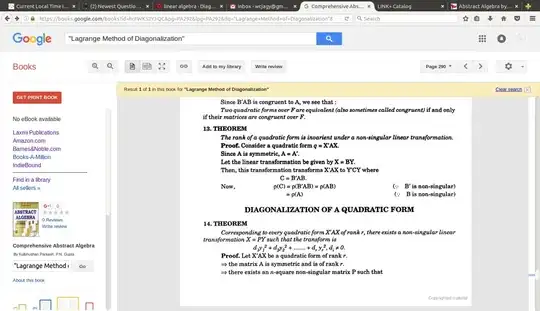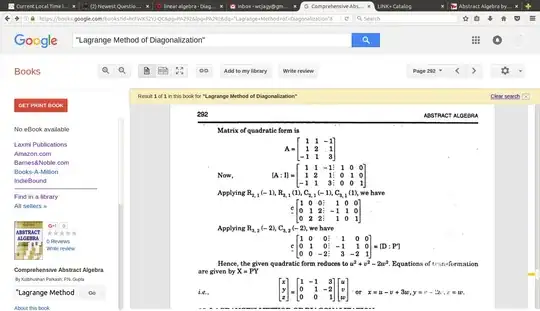see http://math.stackexchange.com/questions/1388421/reference-for-linear-algebra-books-that-teach-reverse-hermite-method-for-symmetr
Also see jpegs at end of answer
$$ P^T H P = D $$
$$ Q^T D Q = H $$
$$ H = \left(
\begin{array}{rrrr}
1 & 2 & 0 & 1 \\
2 & 0 & 3 & 0 \\
0 & 3 & - 1 & 1 \\
1 & 0 & 1 & 4 \\
\end{array}
\right)
$$
==============================================
$$\left(
\begin{array}{rrrr}
1 & - 2 & 0 & 0 \\
0 & 1 & 0 & 0 \\
0 & 0 & 1 & 0 \\
0 & 0 & 0 & 1 \\
\end{array}
\right)
$$
$$ P = \left(
\begin{array}{rrrr}
1 & - 2 & 0 & 0 \\
0 & 1 & 0 & 0 \\
0 & 0 & 1 & 0 \\
0 & 0 & 0 & 1 \\
\end{array}
\right)
, \; \; \; Q = \left(
\begin{array}{rrrr}
1 & 2 & 0 & 0 \\
0 & 1 & 0 & 0 \\
0 & 0 & 1 & 0 \\
0 & 0 & 0 & 1 \\
\end{array}
\right)
, \; \; \; D = \left(
\begin{array}{rrrr}
1 & 0 & 0 & 1 \\
0 & - 4 & 3 & - 2 \\
0 & 3 & - 1 & 1 \\
1 & - 2 & 1 & 4 \\
\end{array}
\right)
$$
==============================================
$$\left(
\begin{array}{rrrr}
1 & 0 & 0 & - 1 \\
0 & 1 & 0 & 0 \\
0 & 0 & 1 & 0 \\
0 & 0 & 0 & 1 \\
\end{array}
\right)
$$
$$ P = \left(
\begin{array}{rrrr}
1 & - 2 & 0 & - 1 \\
0 & 1 & 0 & 0 \\
0 & 0 & 1 & 0 \\
0 & 0 & 0 & 1 \\
\end{array}
\right)
, \; \; \; Q = \left(
\begin{array}{rrrr}
1 & 2 & 0 & 1 \\
0 & 1 & 0 & 0 \\
0 & 0 & 1 & 0 \\
0 & 0 & 0 & 1 \\
\end{array}
\right)
, \; \; \; D = \left(
\begin{array}{rrrr}
1 & 0 & 0 & 0 \\
0 & - 4 & 3 & - 2 \\
0 & 3 & - 1 & 1 \\
0 & - 2 & 1 & 3 \\
\end{array}
\right)
$$
==============================================
$$\left(
\begin{array}{rrrr}
1 & 0 & 0 & 0 \\
0 & 1 & \frac{ 3 }{ 4 } & 0 \\
0 & 0 & 1 & 0 \\
0 & 0 & 0 & 1 \\
\end{array}
\right)
$$
$$ P = \left(
\begin{array}{rrrr}
1 & - 2 & - \frac{ 3 }{ 2 } & - 1 \\
0 & 1 & \frac{ 3 }{ 4 } & 0 \\
0 & 0 & 1 & 0 \\
0 & 0 & 0 & 1 \\
\end{array}
\right)
, \; \; \; Q = \left(
\begin{array}{rrrr}
1 & 2 & 0 & 1 \\
0 & 1 & - \frac{ 3 }{ 4 } & 0 \\
0 & 0 & 1 & 0 \\
0 & 0 & 0 & 1 \\
\end{array}
\right)
, \; \; \; D = \left(
\begin{array}{rrrr}
1 & 0 & 0 & 0 \\
0 & - 4 & 0 & - 2 \\
0 & 0 & \frac{ 5 }{ 4 } & - \frac{ 1 }{ 2 } \\
0 & - 2 & - \frac{ 1 }{ 2 } & 3 \\
\end{array}
\right)
$$
==============================================
$$\left(
\begin{array}{rrrr}
1 & 0 & 0 & 0 \\
0 & 1 & 0 & - \frac{ 1 }{ 2 } \\
0 & 0 & 1 & 0 \\
0 & 0 & 0 & 1 \\
\end{array}
\right)
$$
$$ P = \left(
\begin{array}{rrrr}
1 & - 2 & - \frac{ 3 }{ 2 } & 0 \\
0 & 1 & \frac{ 3 }{ 4 } & - \frac{ 1 }{ 2 } \\
0 & 0 & 1 & 0 \\
0 & 0 & 0 & 1 \\
\end{array}
\right)
, \; \; \; Q = \left(
\begin{array}{rrrr}
1 & 2 & 0 & 1 \\
0 & 1 & - \frac{ 3 }{ 4 } & \frac{ 1 }{ 2 } \\
0 & 0 & 1 & 0 \\
0 & 0 & 0 & 1 \\
\end{array}
\right)
, \; \; \; D = \left(
\begin{array}{rrrr}
1 & 0 & 0 & 0 \\
0 & - 4 & 0 & 0 \\
0 & 0 & \frac{ 5 }{ 4 } & - \frac{ 1 }{ 2 } \\
0 & 0 & - \frac{ 1 }{ 2 } & 4 \\
\end{array}
\right)
$$
==============================================
$$\left(
\begin{array}{rrrr}
1 & 0 & 0 & 0 \\
0 & 1 & 0 & 0 \\
0 & 0 & 1 & \frac{ 2 }{ 5 } \\
0 & 0 & 0 & 1 \\
\end{array}
\right)
$$
$$ P = \left(
\begin{array}{rrrr}
1 & - 2 & - \frac{ 3 }{ 2 } & - \frac{ 3 }{ 5 } \\
0 & 1 & \frac{ 3 }{ 4 } & - \frac{ 1 }{ 5 } \\
0 & 0 & 1 & \frac{ 2 }{ 5 } \\
0 & 0 & 0 & 1 \\
\end{array}
\right)
, \; \; \; Q = \left(
\begin{array}{rrrr}
1 & 2 & 0 & 1 \\
0 & 1 & - \frac{ 3 }{ 4 } & \frac{ 1 }{ 2 } \\
0 & 0 & 1 & - \frac{ 2 }{ 5 } \\
0 & 0 & 0 & 1 \\
\end{array}
\right)
, \; \; \; D = \left(
\begin{array}{rrrr}
1 & 0 & 0 & 0 \\
0 & - 4 & 0 & 0 \\
0 & 0 & \frac{ 5 }{ 4 } & 0 \\
0 & 0 & 0 & \frac{ 19 }{ 5 } \\
\end{array}
\right)
$$
==============================================
$$ P^T H P = D $$
$$\left(
\begin{array}{rrrr}
1 & 0 & 0 & 0 \\
- 2 & 1 & 0 & 0 \\
- \frac{ 3 }{ 2 } & \frac{ 3 }{ 4 } & 1 & 0 \\
- \frac{ 3 }{ 5 } & - \frac{ 1 }{ 5 } & \frac{ 2 }{ 5 } & 1 \\
\end{array}
\right)
\left(
\begin{array}{rrrr}
1 & 2 & 0 & 1 \\
2 & 0 & 3 & 0 \\
0 & 3 & - 1 & 1 \\
1 & 0 & 1 & 4 \\
\end{array}
\right)
\left(
\begin{array}{rrrr}
1 & - 2 & - \frac{ 3 }{ 2 } & - \frac{ 3 }{ 5 } \\
0 & 1 & \frac{ 3 }{ 4 } & - \frac{ 1 }{ 5 } \\
0 & 0 & 1 & \frac{ 2 }{ 5 } \\
0 & 0 & 0 & 1 \\
\end{array}
\right)
= \left(
\begin{array}{rrrr}
1 & 0 & 0 & 0 \\
0 & - 4 & 0 & 0 \\
0 & 0 & \frac{ 5 }{ 4 } & 0 \\
0 & 0 & 0 & \frac{ 19 }{ 5 } \\
\end{array}
\right)
$$
$$ Q^T D Q = H $$
$$\left(
\begin{array}{rrrr}
1 & 0 & 0 & 0 \\
2 & 1 & 0 & 0 \\
0 & - \frac{ 3 }{ 4 } & 1 & 0 \\
1 & \frac{ 1 }{ 2 } & - \frac{ 2 }{ 5 } & 1 \\
\end{array}
\right)
\left(
\begin{array}{rrrr}
1 & 0 & 0 & 0 \\
0 & - 4 & 0 & 0 \\
0 & 0 & \frac{ 5 }{ 4 } & 0 \\
0 & 0 & 0 & \frac{ 19 }{ 5 } \\
\end{array}
\right)
\left(
\begin{array}{rrrr}
1 & 2 & 0 & 1 \\
0 & 1 & - \frac{ 3 }{ 4 } & \frac{ 1 }{ 2 } \\
0 & 0 & 1 & - \frac{ 2 }{ 5 } \\
0 & 0 & 0 & 1 \\
\end{array}
\right)
= \left(
\begin{array}{rrrr}
1 & 2 & 0 & 1 \\
2 & 0 & 3 & 0 \\
0 & 3 & - 1 & 1 \\
1 & 0 & 1 & 4 \\
\end{array}
\right)
$$
=====================================================





